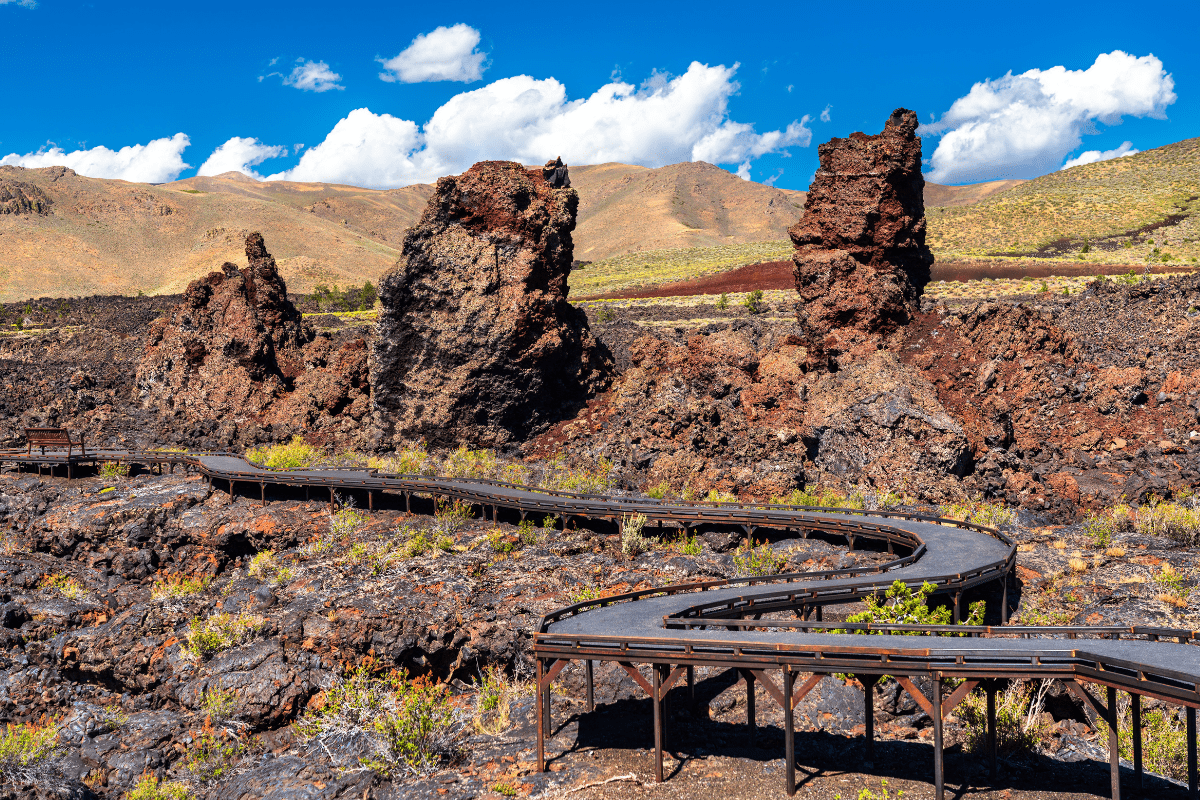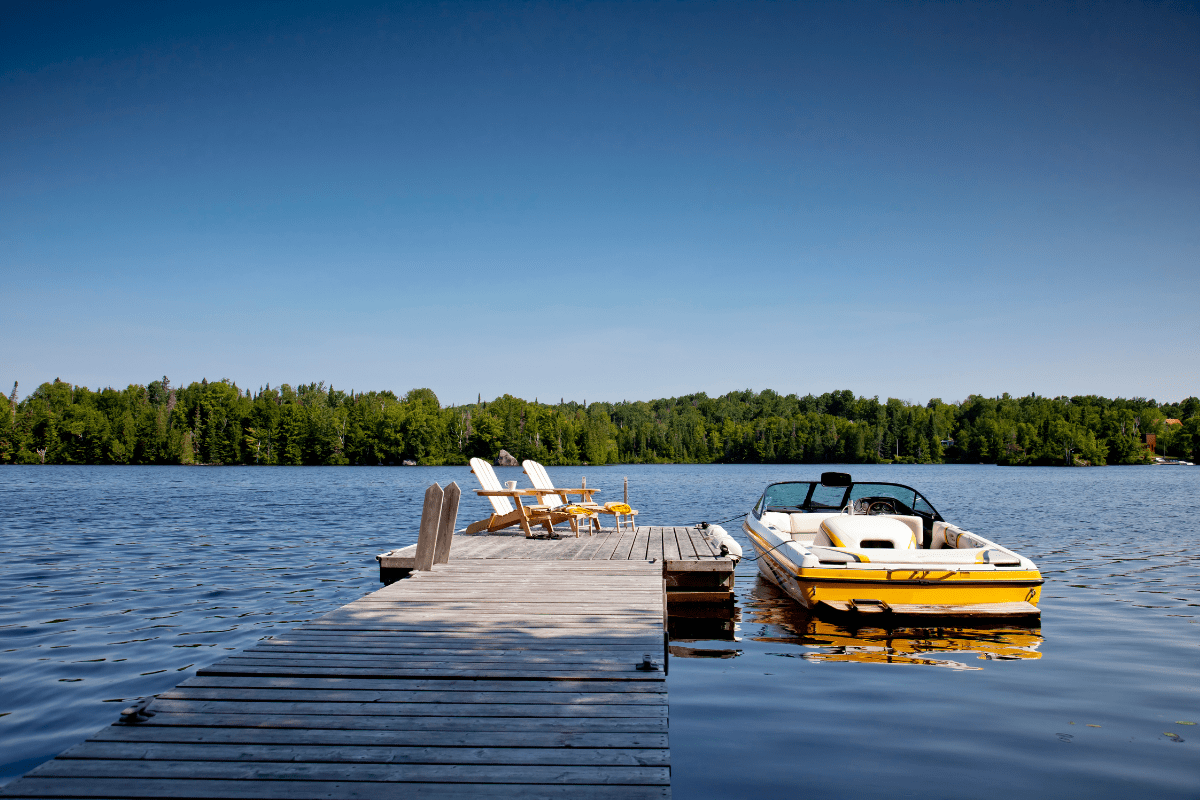Idaho's historic sites tell stories that textbooks somehow forgot to mention. From NASA astronauts stumbling around lava fields to an entire town that accidentally got itself listed on the National Register, these places prove that history doesn't have to be boring when it involves underground mine tours and 30-foot-tall beagle hotels.
The famous spots that actually live up to the hype
Not all tourist traps are created equal. Some historic sites earn their popularity through sheer weirdness, exceptional preservation, or because something genuinely important happened there. Idaho manages all three.
Craters of the Moon: Where astronauts practiced being astronauts
Craters of the Moon National Monument sounds like something a kid made up, but NASA took it seriously enough to send Apollo astronauts here between 1969 and 1972. They figured if you're going to walk on the moon, you might as well practice in Idaho's volcanic wasteland first. The monument charges $15 per vehicle for a seven-day pass, which honestly feels like a bargain for visiting another planet without leaving Earth.
The 7-mile Loop Road stays fully open from May through October, though the visitor center operates year-round for those brave enough to visit when everything's covered in snow. Pro tip: the lava tube caves maintain a constant 50-degree temperature, so bring a jacket even in July. As an International Dark Sky Park, this place transforms into astronomy central after sunset. Just remember that "dark sky" means really, really dark… bring a flashlight or prepare to trip over ancient lava flows.
Old Idaho Penitentiary: 101 years of bad decisions
The Old Idaho Penitentiary in Boise housed over 13,000 inmates during its run from 1872 to 1973. Today, you can explore 30 historic buildings including five different cell houses, death row, and the gallows that saw 10 executions. It's basically a century of criminal justice evolution frozen in time, complete with riot damage from the 1970s.
Adult admission runs $8, with guided tours available for an extra $2 on a first-come basis. Winter hours are noon to 5pm daily, extending to 10am to 5pm during summer. Fair warning: this isn't Disney World. The subject matter gets intense, but the educational value makes it worthwhile for older kids and history buffs who can handle discussions about solitary confinement and capital punishment.
Wallace: The town that listed itself
Wallace Historic District holds the quirky distinction of being the only American town where literally every single structure made it onto the National Register of Historic Places. The entire town. Even the gas station. This "Silver Capital of the World" produced over 1.2 billion ounces of silver, which explains why they could afford to preserve everything.
The Sierra Silver Mine Tour takes visitors underground with retired miners as guides. Tours depart every 30 minutes from May through October for $15 per adult. The mine stays at 50 degrees year-round, so dress like it's October even if you visit in August. Within walking distance, the Wallace District Mining Museum offers 7,000 square feet of exhibits and a mock mine walkthrough for those who prefer their mining history above ground.
Hidden gems that locals hope tourists never find
While famous sites draw tour buses, Idaho's lesser-known historic spots offer equally compelling experiences without the crowds. Some are weird, some are profound, and at least one involves sleeping inside a giant wooden dog.
The Dog Bark Park Inn: History meets whimsy
The Dog Bark Park Inn in Cottonwood pushes the boundaries of "historic accommodation." This 30-foot-tall beagle sculpture, created by chainsaw artists Dennis Sullivan and Frances Conklin, functions as an actual bed and breakfast. You sleep inside a dog named Sweet Willy. Reservations fill months in advance because apparently, lots of people want to sleep in a giant beagle.
Where nuclear history began (in Idaho, of all places)
The Experimental Breeder Reactor-I near Arco changed world history on December 20, 1951, becoming the first nuclear reactor to generate electricity. It powered four whole light bulbs, which doesn't sound impressive until you realize those four bulbs launched the atomic age. This National Historic Landmark offers free guided tours from Memorial Day through Labor Day. The guides know their stuff and can explain nuclear physics without making your brain melt.
Chesterfield: A ghost town with really good bones
Chesterfield Historic Town Site preserves an entire 1880s Mormon pioneer settlement with 27 surviving buildings spread across 100 acres. Unlike touristy ghost towns with gift shops and staged gunfights, Chesterfield maintains authenticity through volunteer preservation efforts by descendants of original settlers. The hand-fired red brick LDS meetinghouse, built between 1887 and 1892, stands as one of Idaho's best examples of pioneer craftsmanship.
Guided tours run Memorial Day through Labor Day from 10am to 6pm Monday through Saturday, though you can explore on your own year-round. The pioneer cemetery offers sobering reminders of frontier life's harsh realities… lots of small headstones from the 1800s.
Treaty Rock: History literally carved in stone
Treaty Rock near Post Falls preserves the only known Native American land agreement physically carved into stone. The 1871 deal between Chief Seltice and settler Frederick Post sits behind some apartments in an unassuming residential area. It's free, it's weird, and it's historically unique. Just remember you're looking at an actual treaty, not graffiti.
Native American sites that demand respect (and deserve it)
Idaho's Indigenous history spans thousands of years, with sites ranging from ancient petroglyphs to locations of recent historical significance. These aren't just photo ops… they're sacred spaces and tragic memorials that require thoughtful visitation.
Nez Perce National Historical Park: 38 sites, one complex story
The park encompasses 38 sites across four states, with 26 located in Idaho. The Spalding Visitor Center near Lewiston serves as your starting point, offering the film "Of One Heart" and extensive exhibits. All sites remain free to visit, though some hold deep spiritual significance for the Nimíipuu people.
Key sites worth your time:
- Buffalo Eddy's ancient petroglyphs
- Weippe Prairie where Lewis met Clark
- Heart of the Monster creation site
- White Bird Battlefield interpretation area
- Camas Prairie seasonal blooms
- Bear Paw Battlefield (Montana extension)
- Clearwater River confluence points
Celebration Park: Idaho's only archaeological park
Located near Melba, this park protects petroglyphs on "melon boulders" created between 100 and 10,000 years ago. For a $2 vehicle entry fee, you get interpretive trails, an atlatl throwing range (ancient spear-thrower for the uninitiated), and a visitor center open April through October. Map Rock might represent the world's oldest map, with Northern Shoshone petroglyphs possibly depicting the Snake River valley for navigation.
Bear River Massacre Site: A difficult but important visit
This Preston-area National Historic Landmark commemorates the largest single slaughter of Native Americans in U.S. history, where over 400 Shoshone died in 1863. The site provides monuments and interpretive materials, with the Shoshone-Bannock Tribes holding annual gatherings. It's not an easy visit emotionally, but it's an essential piece of American history that deserves recognition.
Ghost towns and mining camps worth the terrible roads
Idaho's mining heritage created dozens of ghost towns. Many require high-clearance vehicles, some close entirely in winter, and at least one has mercury-contaminated water. Yet they're absolutely worth visiting if you're prepared.
Silver City: The ghost town that refuses to die
Silver City in Owyhee County stands as one of America's best-preserved ghost towns with 75 structures from its 1860s silver boom. The 23-mile gravel road from Murphy requires a high-clearance vehicle and closes completely from November through May. You must bring your own water due to mercury contamination from historic mining.
Despite these challenges, the intact buildings make the summer journey worthwhile:
- 1892 Standard School
- Masonic Hall architectural gem
- Historic Idaho Hotel structure
- Multiple original residences
- Mining operation remnants
Call Owyhee County Dispatch at 208-495-1154 for current road conditions before attempting the drive.
Land of the Yankee Fork: Three ghost towns, one state park
Near Challis, this state park interprets mining history through Custer, Bayhorse, and Bonanza ghost towns. Budget $2 for museum admission, $7 for parking that covers all ghost town sites, and $5 for the Yankee Fork Gold Dredge guided tour. The 46-mile Custer Motorway follows the original 1879 toll road but requires high-clearance vehicles and becomes impassable during spring snowmelt.
Burke: The ghost town that's actually ghostly
Burke in Shoshone County offers a true abandoned experience. The railroad once ran through the Tiger Hotel's lobby because the canyon was too narrow for both a street and tracks. Located seven miles from Wallace via deteriorating State Highway 4, Burke requires extreme caution. Heavy metal contamination makes water unsafe, "No Trespassing" signs mark private property, and cell service doesn't exist. Visit at your own risk, but wow, what a risk.
Pioneer trails where people literally died of dysentery
The Oregon Trail through Idaho created numerous historic sites. Yes, the computer game was based on real events. No, it wasn't as fun as the game made it seem.
Three Island Crossing: The worst place to ford a river
This state park near Glenns Ferry preserves one of the most dangerous river crossings on the Oregon Trail. The free Oregon Trail History and Education Center operates daily from 9am to 4pm. Original wagon ruts remain visible throughout the park, with 5.6 miles of interpretive trails explaining why so many pioneers thought "maybe we should have stayed in Missouri."
The park hosts an annual crossing reenactment the second Saturday in August, though modern participants use safety equipment the pioneers definitely didn't have.
Franklin: Idaho's oldest town (and it shows)
Established in 1860, Franklin holds the distinction as Idaho's oldest permanent settlement. The Greek Revival Hatch House from 1872 and the stone Doney House from around 1870 represent rare examples of Mormon pioneer architecture that survived. The Relic Hall operates Tuesday through Saturday from 11am to 3pm during summer, providing context for Mormon colonization patterns that established 16 additional Idaho communities.
Massacre Rocks: Cheerfully named, historically significant
Despite its ominous name, Massacre Rocks State Park offers fascinating Oregon Trail history. Register Rock, protected by a pavilion, displays pioneer inscriptions in axle grease… basically 1800s graffiti with historical significance. The 7.5 miles of trails with interpretive waysides explain both the geology and history. The park stays open year-round, though April through October offers the best weather.
Practical stuff nobody tells you until it's too late
When to visit (and when you really shouldn't)
Summer from June through September offers full access to all sites but brings crowds to popular destinations. Mountain ghost towns typically remain snow-blocked from November through May. Spring and fall shoulder seasons provide ideal conditions with moderate temperatures and smaller crowds. The camas blooms at Nez Perce cultural sites peak in May and June, creating spectacular purple prairie displays.
Winter doesn't eliminate all options. Urban historic sites in Boise, Pocatello, and Coeur d'Alene remain fully accessible. Museums maintain year-round schedules, and the Old Idaho Penitentiary operates through winter with noon to 5pm hours.
Essential planning resources
Check these before heading out:
- Idaho 511 for road conditions
- Owyhee County Dispatch (208-495-1154) for Silver City
- Individual site websites for current hours
- Weather forecasts for mountain areas
- Tank full of gas (seriously)
- Downloaded offline maps
- Emergency supplies and water
- Cash for remote locations
Photography and respect
Most sites welcome photography for personal use, with commercial filming requiring permits. Night sky photography at Craters of the Moon benefits from International Dark Sky Park designation. Early morning and late afternoon provide optimal lighting for ghost towns.
Respect remains paramount at Native American cultural sites and locations of tragic events like Minidoka National Historic Site, where 13,000 Japanese Americans were incarcerated during World War II. Some moments deserve contemplation more than Instagram posts.
Making it all work without losing your mind
Idaho's historic sites preserve complex narratives of the American West, from Indigenous peoples' millennia of occupation through mining booms, pioneer settlements, and military installations. These locations offer tangible connections to the struggles, triumphs, and daily lives of those who shaped this landscape.
Multi-day itineraries work best given Idaho's size. A three-day Nez Perce heritage tour might include the Spalding Visitor Center, White Bird Battlefield, and Buffalo Eddy petroglyphs. A five-day mining circuit could encompass Idaho City, Land of the Yankee Fork ghost towns, and Wallace's underground mine tours.
Local historical societies provide invaluable resources for discovering lesser-known sites. County museums maintain research libraries and photograph collections documenting sites that no longer exist physically. Volunteer docents and local historians can share stories that interpretive signs never could.
Whether you're exploring famous landmarks or seeking hidden gems, Idaho's historic sites offer more than photo opportunities. They provide authentic experiences that illuminate how the past continues shaping the present across this surprisingly complex state. Just remember to bring a jacket for the mine tours, water for the ghost towns, and respect for the sacred sites. History might be old, but it doesn't have to be boring… especially when it involves giant beagles and astronaut training grounds.





